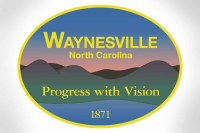Maggie Valley development ordinance nearing completion

After years of fits and starts, Maggie Valley’s unified development ordinance is finally about to see the light of day, and town officials are hoping for as much public input as possible to ensure a smooth transition.
“The UDO, or unified planning and development ordinance, consolidates those related ordinances into one,” said Ron Hancock, Maggie Valley’s town planner. “It just makes it easier and provides more continuity for developers to know what’s expected of them.”
Hancock said that prior to working for the town, he’d worked for the N.C. Department of Commerce performing similar tasks, like writing zoning, subdivision and sign ordinances.
In Maggie’s case, the zoning ordinance hadn’t been updated comprehensively since 1998, but a number of amendments and revisions have occurred, making the ordinance a bit convoluted.
On March 14, Hancock and the planning board held a joint meeting with the Maggie Valley Board of Aldermen to discuss what’s being called “a rough draft of the first draft” of the UDO.
A number of troublesome town issues will be addressed, including new signage requirements, a subdivision ordinance, and additional use standards for intense-use parcels, like cell towers, gas stations and auto service shops, but perhaps the most significant change in the ordinance is a proposal that would almost triple the number of different zoning districts in town.
Related Items
Right now, Maggie Valley only has five zoning districts — low, medium and high density residential, community attraction and neighborhood business.
If adopted as proposed, nine more zones would join those five, including rural residential, seasonal residential and mobile home park.
Rural residential would be an even lower density than the current R-1 district, which has a minimum lot size of 0.32 acres and a maximum of three units per acre. The proposed R-0 district would increase the minimum lot size to half an acre with a maximum of two units per acre.
Seasonal residential, designated as R-4, would allow for 14 units per acre with a minimum lot size of 0.07 acres, and is intended for vacation cabins and the like. The existing R-3 high-density zoning allows up to 13 units per acre and a minimum lot size of 0.16 acres.
The mobile home park district, called MHP, isn’t really a district of its own, but with town approval would instead “float” upon an R-3 district — currently the town’s highest density district.
Minimum lot size in the MHP district would be 2 acres, upon which up to eight dwellings per acre could be situated. Not all R-3 districts would host an MHP, but all MHPs would be hosted by an R-3.
According to Hancock’s PowerPoint presentation, other new non-residential districts include a town center district intended to serve as “a localized community gathering place in town” that would include “a mix of shops, restaurants, public and open space and activities for families and tourists,” as well as three new mixed use districts.
The Soco Road mixed-use district would hug either side of Soco near the central and eastern half of Maggie Valley and is intended for dense commercial and residential development.
The Moody Farm mixed-use district would likewise encourage more dense development but has slightly larger minimum lot sizes than the Soco Road district, as it’s intended to also preserve the somewhat rural characteristics of the district.
The Attraction mixed-use district will be established to promote economic development on larger parcels; this district happens to encompass shuttered Ghost Town in the Sky amusement park and areas around it.
Although some of the proposed changes and additions in the draft UDO would allow a “grandfathering” period for nonconformity, some would require immediate conformity upon adoption of the ordinance; Hancock said the town would consult with its attorney to determine applicability.
There’s still a lot up in the air at this point, but as the document progresses through the necessary steps prior to adoption, it’s important to note that the public will have ample opportunity to learn about and comment on the plan’s various aspects.
“We’re going to finish up the draft this month and have it ready for planning board review in April,” Hancock said.
The planning board will eventually present its recommendation on the plan to the board of aldermen, which will have final say as to whether it’s adopted or not.
Between now and then, said Hancock, there will be an “open house, drop-in” kind of event, as well as at least one — and probably two — formal public hearings taking place before aldermen cast their votes.”
“The doc is still a fairly rough draft, during and after the planning board recommendation there will probably a little back, forth depending on public input,” he said.









